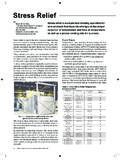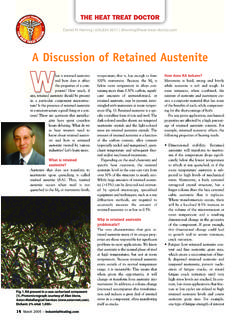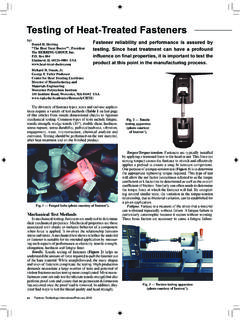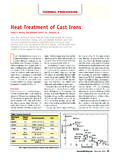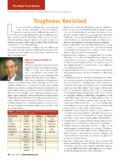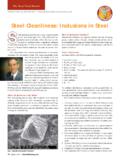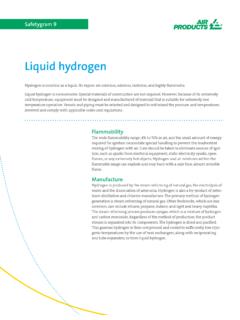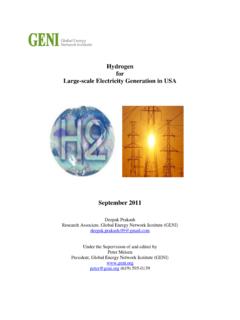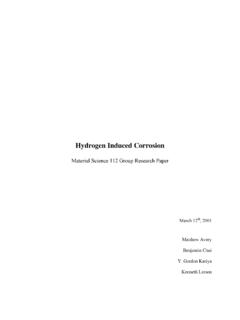Transcription of Hydrogen Embrittlement - Heat Treat Doctor.com
1 Hydrogen Embrittlement by: Daniel H. Herring Although many of the most severe Hydrogen The Heat Treat Doctor , President The HERRING GROUP, Inc. Embrittlement problems have occurred in Box 884 aircraft applications, it should be remembered Elmhurst, IL 60126-0884 USA. that it doesn't have to fly in order to die . Embrittlement is a phenomenon that causes loss of ductility in a material, thus making it brittle. There are a number of different forms including: Environmentally Induced Cracking. Stress Corrosion Cracking. Hydrogen Embrittlement . Corrosion Fatigue. Liquid Metal Embrittlement .
2 Of these, Hydrogen Embrittlement is responsible for a surprising number of delayed failures and problems with products produced from wire, especially if they undergo secondary processing operations such as plating. The factors (see Figure 1) responsible for this type of failure include having a susceptible material, an environment conductive to attack and the presence Fig. 1 Factors contributing to Hydrogen Embrittlement . of stress (internal or applied). Once two of these three factors are present, failure is inevitable. How Hydrogen Gets In Hydrogen Embrittlement is also known as Hydrogen It is generally agreed that Hydrogen , in atomic form, induced cracking or Hydrogen attack.
3 Materials that will enter and diffuse through a metal surface whether are most vulnerable include high-strength steels, ti- at elevated temperatures or ambient temperature. tanium and aluminum alloys and electrolytic tough Once absorbed, dissolved Hydrogen may be present pitch copper. Hydrogen Embrittlement mechanisms either as atomic or molecular Hydrogen or in combined (see Figure 2) can be aqueous or gaseous and involve molecular form ( , methane). Since these molecules the ingress of Hydrogen into the metal, reducing its are too large to diffuse through the metal, pressure ductility and load bearing capacity.
4 Stress below the builds at crystallographic defects (dislocations and yield stress of the susceptible material then causes vacancies) or discontinuities (voids, inclusion/matrix subsequent cracking and catastrophic brittle failures interfaces) causing minute cracks to form. Whether this (see Figure 3). absorbed Hydrogen causes cracking or not is a complex Fig. 2 Hydrogen Embrittlement mechanisms. xx Wire Forming Technology International/Fall 2010. interaction of material strength, external stresses and temperature. Sources of Hydrogen include heat treating atmos- pheres, breakdown of organic lubricants, the steelmak- ing process ( , electric arc melting of damp scrap), the working environment, arc welding (with damp electrodes), dissociation of high pressure Hydrogen Fig.
5 3 Hydrogen Embrittlement and gas and even grinding (in a wet environment). failure of a hard Parts that are undergoing electrochemical surface Treat - chromium-plated ments such as etching, pickling, phosphate coating, chain conveyor bolt. corrosion removal, paint stripping and electroplating are especially susceptible. Of these, acid cleaning is the most severe, followed by electroplating at high cur- rent (these are less efficient and create more Hydrogen even though they produce a better plated structure), electrolysis plating and conversion coatings. Nature & Effect of Hydrogen Attack Although the precise mechanism(s) is the subject of active investigation, the reality is that components fail due to this phenomenon.
6 It is generally believed that all steels above 30 HRC are vulnerable, as are materials such as copper, whether tough pitch or oxygen-free, titanium and titanium alloys, nickel and nickel alloys and the like. Examples of Hydrogen damage and ways to avoid it include the following. Problem: Internal cracking or blistering. Solutions: Use of steel with low levels of impuri- Fig. 4 Intergranular fracture due to Hydrogen Embrittlement (photo courtesy of Aston ties ( , sulfur and phosphorus); modifying the Metallurgical Services Co., Inc.). environment to reduce Hydrogen charging; use of surface coatings and effective inhibitors.
7 Particularly susceptible. Hydrogen Embrittlement is Problem: Loss of ductility. considered the Achilles heel of high strength ferrous Solutions: Use of lower strength (hardness) or high steels and alloys. resistance alloys; careful selection of materials of And nonferrous materials are not immune to attack. construction and plating systems; heat treatment Tough-pitch coppers and even oxygen-free coppers (bakeout) to remove absorbed Hydrogen . are subject to a loss of (tensile) ductility when ex- Problem: High temperature Hydrogen attack. posed to reducing atmospheres. Bright annealing in Solutions: Selection of material (for steels, use of Hydrogen bearing furnace atmospheres, oxy-acety- low and high alloy Cr-Mo steels, selected Cu alloys, lene torch brazing and furnace brazing are typical nonferrous alloys); limit temperature and partial processes that can create Hydrogen Embrittlement of pressure H2.
8 These materials. Since a metallurgical interaction occurs between atomic The attack in these copper alloys involves the diffusion Hydrogen and the crystallographic structure, the abil- of atomic Hydrogen into the copper and subsequent ity of the material to deform or stretch under load is reduction of cuprous oxide (Cu2O) to produce water inhibited. Therefore, it becomes brittle under stress vapor and pure copper. An embrittled copper often or load. As a result, the metal will break or fracture at can be identified by a characteristic surface blister- a much lower load or stress than anticipated.
9 It is this ing resulting from expansion of water vapor in voids lower breaking strength that makes Hydrogen embrit- near the surface. Purchasing oxygen-free copper is no tlement so detrimental. guarantee against the occurrence of Hydrogen embrit- In general, as the strength of the steel goes up, so tlement, but the degree of Embrittlement will depend does its susceptibility to Hydrogen Embrittlement . on the amount of oxygen present. High-strength steel, such as quenched and tem- For example, CDA 101 (oxygen-free electronic) allows pered steels or precipitation-hardened steels, is up to 5 ppm oxygen while CDA 102 (OFHC) permits Fall 2010/Wire Forming Technology International xx Hydrogen Embrittlement .
10 Continued up to 10 ppm. A simple bend test is often used to Temperature and pressure. detect the presence of Hydrogen Embrittlement . Met- Presence of solutions or solvents that may undergo allographic techniques (Figure 4) can also be used to some reaction with metals ( , acidic solutions). look at the near surface and for the presence of voids at grain boundaries. Type of alloy and its production method. Amount of discontinuities in the metal. How Hydrogen Gets Out? Treatment of exposed surfaces (barrier layers, , Hydrogen absorption need not be a permanent condi- oxide layers as Hydrogen permeation barriers on tion.)
